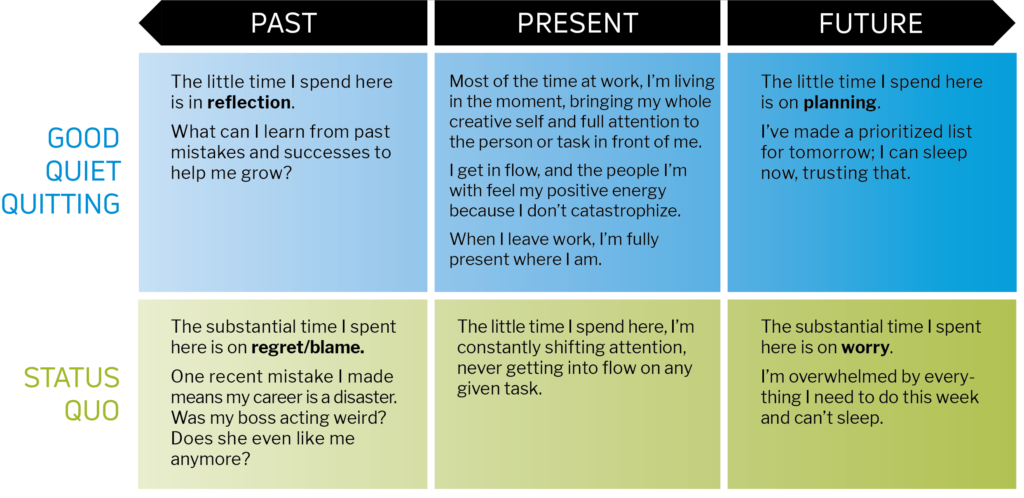The internet is ablaze once more with a buzzword: quiet quitting. As business publications catch up to the TikTok phenomenon, you can now read about the trend everywhere from Forbes to the Wall Street Journal. This backlash against hustle culture is everywhere, and yet I’d offer this provocation: Why are we surprised?
Like a tired prophet from the wilderness, Gallup released its 2022 State of the Global Workplace Report, offering this bleak nugget:
“Do employees find their work meaningful and rewarding? Do they think their lives are going well? Do they feel hopeful about the future? The short answer is that most employees around the world would answer ‘no’ to all three questions.”
You might be tempted to despair when Gallup reminds us that only 21% of employees are engaged at work – until you read that 21% is the second-highest score since the 2009 low of 12%. In short: We’ve had an engagement problem for a long time. It feels disingenuous to be shocked that employees are saying it aloud on TikTok.
When to Fan the Flame of Quiet Quitting
People can’t innovate from a place of scarcity. When we tie our mental and emotional energy so closely to work successes and failures, it’s only a matter of time till we burn out. So many people waste headspace rehashing past mistakes or worrying about the future that they’re never in the present doing their best work. When they do manage a vacation, they’re not fully on the beach; instead, they’re checking in with work out of a general sense of anxiety.
These never-present individuals live their whole lives in a state of “waking sleep” identified by researchers Derek Roger and Nick Petrie in their book, Work without Stress. The healthiest quiet quitters are waking up to this principle of theirs: you don’t have to turn work pressures (which are inevitable) into work stress (which is adding avoidable, negative emotion to pressure). In practice, it looks something like this:

In short, the best humans are fully present, most of the time. When they’re at their desks, they work their tails off and take pride in the results. When they’re with their families or friends, they’re fully present, not thinking about their jobs. And on the rare occasions when they spend their mental energy in the past or future, they deliberately focus their energy on reflection (not regret) and planning (not worry).If quiet quitting means encouraging people to “right size” work in their mental space, we should encourage it. According to Petrie and Roger, this kind of detached perspective makes people better at their jobs.
When to Fight the Quiet Quitting
The more insidious form of quiet quitting is disengagement. Employees who “phone it in” (an expression that merits revisiting in a virtual working world?) are not bringing their creativity to work, which makes them unhappy and their companies less productive. How do we tackle this longstanding reality?
1. Align and Inspire the Top
When was the last time your CEO told a great story? Employees want to feel caught up in the drama of where the company is headed and see their role as protagonists in that narrative. Yet in Root’s work with senior teams, we find that even if leaders are aligned on the overall direction, they’re often fuzzy on the details of how they’ll get there – let alone able to tell an inspiring story about it.
If we’re going to wake people up from their quiet-quitting stupor, we must equip senior teams to tell the compelling, authentic story of their strategies. The crickets following the question, “Does anyone have any questions?” don’t denote understanding – they denote disengagement.
Leaders must understand that it’s not enough for senior teams to understand the end goal. They must also feel comfortable discussing the steps their teams need to take along the way to reach that goal. People want to feel informed about the whole process. When people are told a compelling story, there is less room for them to create their own, often misinformed, narrative, and they are encouraged to be engaged in the present.
2. Rethink the Middle
Middle managers are the place to stop quiet quitting, accounting for 70% of the variance in employee engagement.
How much do you invest in them? How much of that training is leadership-oriented vs. functional? How do we reengineer manager development programs to help managers rethink their role? On our best days, employees want to feel:
- Supported by Leadership – Do your managers see their role as a mother bear, fighting to get her cubs everything they need to thrive?
- Infused with Purpose – Can your managers articulate the company strategy, so that their teams feel inspired about how their work contributes to the larger purpose?
- Good at Their Jobs – Do your managers track and celebrate when their people get strong results? When they live your company values?
- Connected to Their Colleagues – Do your managers know how to build authentic connections between team members, even in a virtual world? If their teams left the company, would they regret the decision because they deeply miss their colleagues?
If we’re not training middle managers to meet these needs, we’re missing a chance to stamp out quiet quitting at the most critical intervention point. Root has discussed the importance of focusing on managers for years. They are the connection between senior leaders and workers and typically in desperate need of better training and guidance. The time is now for leaders to reevaluate how well their managers are being supported. And make necessary changes quickly.
3. Don’t Send Communications. Start Conversations.
PSA: People are lonely, and your town hall PowerPoint isn’t helping. The slickest corporate communications will never overcome the ubiquitous multi-tasking that plagues us, keeping us from truly being present with the people on our video calls or meetings.
There’s a reason people go to the baseball game or theater when we would have a better view of the action at home – there’s an electricity in crowds. And then we often go to the bar afterwards, reliving the home run or the most dramatic moment of the play. Work should be no different. Humans make meaning together, and the only way to pull them out of their multitasking malaise is to drop them into conversation with each other.
Why is it, then, that companies communicate new corporate strategies and initiatives in one-way presentations that people view at their desks, and then are shocked when they don’t care? The future of corporate communications is conversation. Let’s stop talking at our employees and give them ways to unpack the company direction together. When we do, they’ll get closer to one another – and to the collective purpose that ties them all together as one, corporate body.
Quiet Quitting: It’s Time to Solve Longstanding Engagement Issues
So, what are you going to do about quiet quitting? At the individual level, when a person shows signs of burnout, teach them how to productively detach and appropriately balance work in their mental landscape. Teach them to reflect deeply on their past work and draw out the lessons. Teach them to prioritize future work, so that their hustle has the biggest impact within their allotted work time. At the corporate level, get serious about making systemic changes to address this very old and ubiquitous problem of abysmal engagement.
These same considerations and tactics should be applied throughout the company as well. Team leaders should be better supported by upper-level management and encouraged to do more in terms of managing the feelings and attitudes of their team members. If someone appears disengaged, they probably are. If someone is getting their work done, but never giving new ideas or offering to help a colleague, we all know what this means by now – quiet quitting. The only way to do something about the dismal engagement scores that Gallup continues to report is to become active in this battle against mediocrity, while arming people with the skills and knowledge on how to become more engaged in their present task – whether at work or beyond.
Quiet quitting isn’t a trendy new workplace phenomenon. It’s a longstanding engagement issue that we can help you solve. If you’re ready to start tackling this with your team, let’s chat.









